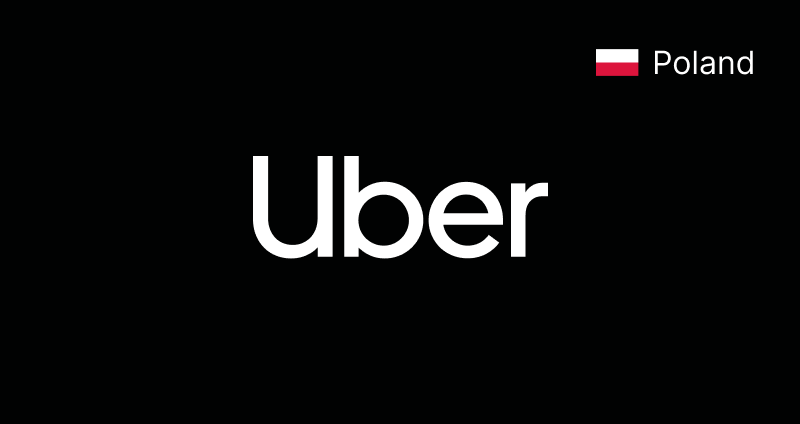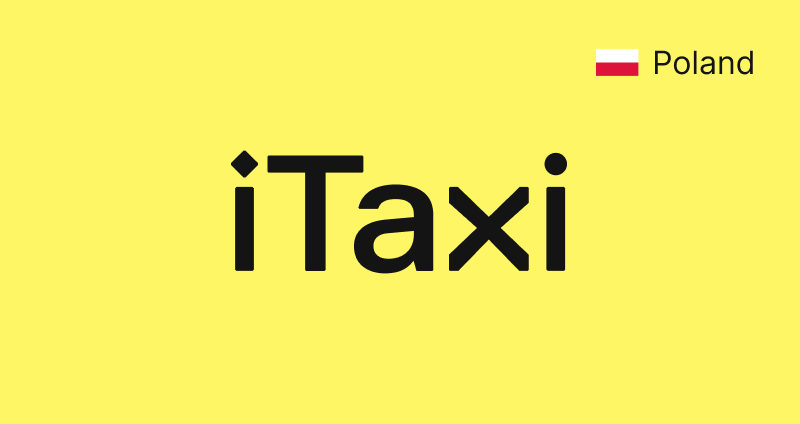Best taxi app in Poland: pick your model


Poland is often mentioned in mobility conversations because it shows how ride hailing evolved in Central Europe. The shift from phone dispatch to app based rides did not happen overnight, but now it feels completely natural for local riders. When someone wants a car, they don’t think in categories like “company”, they think in categories like “which app will get me a driver fastest”. This mindset is important for a founder who is about to decide what type of taxi platform they want to build. The keyword taxi apps poland actually reflects how people already search and compare options. They assume the app is the core value. Before choosing your model, it makes sense to understand what exactly the leading apps here do well, and why they dominate trips. We research the strongest Polish apps so we can give our clients only the best product direction. Mobion works as a product partner.
Top Poland taxi apps you should analyse before you launch
- Uber - global ride platform🌍
- Bolt - fast urban rides🚀
- FreeNow - licensed fleets aggregator📝
- iTaxi - classic Polish taxi🚖
- Taxi Polska - traditional regional network🚕
Uber Poland overview

Uber in Poland functions almost like a basic infrastructure layer. People do not think about the brand, they think about the next trip they need to take, and Uber is simply the most direct instrument for doing that. The interface is familiar from other countries, which makes onboarding unnecessary for tourists and migrant workers. Most of the usage happens in big cities, especially near stations, office districts, event venues and shopping galleries. The value here is not in complexity, but in low friction. Riders expect that the route preview is accurate, the price is clear enough to understand, and the ETA is believable. This created a culture where the ideal ride app is the one that stays out of the way.
Taxi app
When you open Uber in Warsaw or Kraków you instantly feel how extremely unforgiving this market is to any rough edge. Riders expect everything to be quick and predictable. Biometrics to log in. Final total shown before you commit. Live location sharing that actually works when you are somewhere noisy like Warszawa Centralna at 18.30. Local operators told me that taxi in poland is now a “micro trust” game. Whoever removes friction at the micro level wins. It is not enough to just move a car icon on a map. Passengers reward apps that feel like someone paid attention to tiny details that make a bad evening turn normal again.
Pricing
Uber Poland quietly engineered something brutal in Warsaw. They set the psychological max price a rider accepts per kilometre. And the threshold is not published anywhere. People just hold it in their head. If your number goes above that anchor they instantly bounce. This is why software suddenly matters. Stable pricing only exists if your dispatch, routing and trip scoring modules talk to each other in real time. Manual operations cannot hold that line.
Pros and Cons
Pros:
- huge driver supply
- very fast pickup in big cities
- clear in-app price before booking
- wide coverage inside Poland and abroad
Cons:
- price can surge on peak hours
- quality depends on each individual driver
- support mostly app based, not phone based
Bolt Poland overview

Bolt looks familiar on the surface because the core product flow is almost identical to Uber. But operators in Warsaw tell a different story when they talk margins. Bolt optimises for variable input cost. More flexible driver onboarding. Lighter compliance weight. Faster supply activation in a district. This is the part local owners watch carefully because it is exactly where bolt taxi poland threatens them more than Uber. Uber sets the expectation standard. Bolt attacks the economic gap. When wage inflation in the capital keeps drifting up and fuel has noise every quarter the business that can flex cost structure faster can steal the rider in the micro moment. This ability to re compress supply fast is a real strategic weapon.
Taxi app
Bolt intentionally organised their app around two promises for Warsaw. First, you see the ETA and it actually matches reality. Second, the commitment gap between tap and pickup is usually tiny in central districts. This is important for owners because this is not “tech aesthetic”. This is the economic centre of their value prop. When riders feel that flow, they care less about micro deviations in fare. This is how bolt taxi app poland protects its daily active habit. But there is also a strategic tax here. Bolt depends heavily on constantly fresh supply to hold this feeling. If the supply graph drops, the illusion evaporates.
Pricing
In Warsaw between 18:00 and 19:00 people are tired and they just want to get home without the feeling they are being taken advantage of. This is exactly why bolt taxi price per km poland became a silent norm. Polish riders do not need the cheapest possible fare. They need a number that feels sane and not opportunistic. And this is where local taxi owners either win or die. You cannot outrun this psychology with old dispatch logic.
Pros and Cons
Pros:
- instant confirmations
- pricing usually acceptable
- strong evening conversion
Cons:
- more exposed to regulation shifts
- no local brand equity
- ETA drops fast when supply dips
FreeNow Poland overview

FreeNow is an app based mobility platform working across many European cities, including major hubs in Poland. Local users can order a licensed taxi, private hire car or ride with partner fleet drivers. In practice FreeNow taxi poland is not tied to one single model. We simply connect customers with a network of approved transport suppliers. This flexibility makes FreeNow useful for daily commutes, airport rides and short distance travel in urban areas where customers want an app experience, but still want real world service standards.
Taxi app
Our application runs on iOS and Android. The interface is designed so that people can complete a booking in a few taps. The freenow taxi app shows where the nearest car is, how long the arrival will take and what payment methods can be used. Riders can pay inside the app and keep their receipts in one place. There is no need to negotiate pricing with the driver on the street. The app flow is built around quick decision making: choose a ride type, confirm the pickup point, finish the booking.
Pricing
Prices differ between cities, ride types and time of day. FreeNow does not set a single national tariff, because different suppliers use different billing models. In general the cost follows the market level for taxi app in poland in each location. Some taxi categories run on standard taximeters. Other categories use app based price estimates. The customer sees the estimate or fixed price before confirming. This is made to reduce uncertainty and to keep the decision simple.
Pros and Cons
Pros:
- many ride types in one app
- transparent pricing before the trip
- modern interface
- strong presence in large cities
Cons:
- coverage outside big metropolitan areas is limited
- price levels vary by supplier group
- surge can appear in peak hours
iTaxi Poland overview

iTaxi is a licensed taxi platform operating across major Polish cities including Warsaw, Krakow, Gdansk and Wroclaw. Our service is built on official taxi rules. We work only with certified drivers who use fiscal meters or approved fixed fares. For business teams we provide invoicing, scheduled rides and consistent service standards. In practice this means travellers can rely on iTaxi for airport transfers, hotel pickups and meetings without price shocks or unpredictable last minute drivers.
Taxi app
The iTaxi app is available for iOS and Android. Booking takes a few taps, and customers can pay by card or cash. We focus on a simple taxi in poland app experience where the user immediately understands what is happening: where the driver is, how long the car will take to arrive and what the ride will roughly cost. If anything goes wrong, our call center can step in. We are not a marketplace of hobby drivers. We digitise the classic licensed taxi model that Polish passengers already trust.
Pricing
Pricing depends on the city, time and tariff zone. In Warsaw the base fare usually ranges from 8 to 11 PLN and distance pricing is about 3 to 4 PLN per kilometre. Night and holiday tariffs are higher. Airport zones follow local regulations. Our pricing is stable because tariffs are not invented on the fly. When customers ask about taxi price poland we explain that official meters and regulated tables protect them from aggressive dynamic pricing.
Pros and Cons
Pros:
- licensed and regulated drivers
- consistent tariffs
- strong fit for business travel
- reliable for airports and transfers
Cons:
- limited coverage in small towns
- slower pickup outside central zones
- fewer promo campaigns compared to gig apps
Taxi Polska overview

Taxi Polska is one of the longer standing taxi brands in Poland. The company works through regional fleets, but under a single nationwide name, so customers recognise it when they move between cities. The brand focuses on regulated rides and licensed drivers. Because of this, many passengers still associate taxi polska with a more classic, steady service standard, especially when they prefer a familiar provider instead of a newer gig based option.
Taxi app
The Taxi Polska app lets riders book without calling dispatch. The interface is simple on purpose: pick the starting point, check the route on the map and choose the payment method. The idea is to make poland taxi booking less manual and more structured. The app uses GPS location and sends the request directly to the closest available licensed car. It keeps the booking process straightforward, while relying on traditional taxi fleets that already operate locally.
Pricing
Taxi Polska uses official tariff rules. Taxi prices in poland are set by local authorities, which means the starting fee and per kilometre rate depend on the region. Night and holiday surcharges follow written regulations. Because the final cost is calculated on a fiscal meter, the rider usually sees a predictable total at the end of the journey.
Pros and Cons
Pros:
- licensed and regulated fleet network
- consistent brand in multiple cities
- stable tariff logic
- familiar for riders who prefer classic taxi
Cons:
- coverage quality depends on region
- slower pickup outside central areas
- fewer modern in app features compared to global ride apps
What poland taxi company trends show today
The Polish taxi market is in a hybrid stage. Traditional fleets still hold strong positions in big cities, but the overall direction is shifting toward platforms that combine licensed taxi and app based ride models. A poland taxi company today cannot rely only on dispatch phones or long established routines. Passengers expect mobile booking, real time location data, transparent fares and flexible payment methods. At the same time, the taxi service poland market is still more regulated than many other European countries. Because of this, a lot of the modernisation happens inside existing legal frameworks. Apps are added on top. Data improves routing. But the core idea stays the same: the rider gets a licensed car with clear rules.
How to choose your own taxi app model and start
When a company decides to enter this market, the first step is to define what exactly they want to operate. Some teams want to run a pure dispatch model with licensed cars. Others want a hybrid approach that mixes traditional fleets with pre booked app rides. There is also a trend to start as a focused niche poland taxi app in one region, then scale to multiple cities later. The right choice depends on what fleet assets already exist, what regulatory demands apply in that city and how fast the business wants to onboard drivers.
If you want to build a modern digital taxi layer and test how it could work in your region, you can simply Request Mobion demo and evaluate the operational logic before you commit fully to development.
F.A.Q.
Ready to revolutionize your taxi business?
Choose what you need: